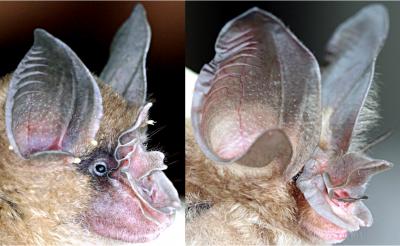The mystery of a rare bat's unusually large nose has been solved, according to an article in Physical Review Letters.
The adult Bourret's horseshoe bat, known scientifically as the Rhinolophus paradoxolophus meaning paradoxical crest, has a nose roughly 9 millimeters in length but the typical horseshoe bat's nose is half that long, said Rolf Mueller, an associate professor with the Virginia Tech mechanical engineering department and director for the Bio-inspired Technology (BIT) Laboratory in Danville, Va. "This nose is so much larger than anything else," among other bats of the region, he said.
Mueller's findings show that the bat uses its elongated nose to create a highly focused sonar beam. Bats detect their environment through ultrasonic beams, or sonar, emitted from their mouths -- or noses, as in the case of the Rhinolophus paradoxolophus bat. The echoes of the sound wave convey a wealth of information on objects in the bat's environment. This bat from the remote rainforests of South East Asia received its name 58 years ago because of its mysterious trait.

These images are of the noseleaf of a typical horseshoe bat species (left) vs. that of Bourret's horseshoe bat, the Rhinolophus paradoxolophus (right). Computer modeling indicates the extreme nose is used to create a highly focused sonar beam. One of the researchers is Rolf Mueller, an associate professor with the Virginia Tech mechanical engineering department, who directs the Bio-inspired Technology Laboratory. His research includes biosonar-inspired autonomous robots and statistical signal processing methods in natural outdoor environments. Credit: Rolf Mueller
Much like a flashlight with an adjuster that can create an intense but small beam of light, the bat's nose can create a small but intense sonar beam. Mueller and his team used computer animation to compare varying sizes of bat noses, from small noses on other bats to the large nose of the paradoxolophus bat.
In what Mueller calls a perfect mark of evolution, he says his computer modeling shows the length of the paradoxolophus bat's nose stops at the exact point the sonar beam's focal point would become ineffective.
"By predicting the width of the ultrasonic beam for each of these nose lengths with a computational method, we found that the natural nose length has a special value: All shortened noses provided less focus of the ultrasonic beam, whereas artificially elongated noses provided only negligible additional benefits," Mueller said. "Hence, this unusual case of a biological shape can be predicted accurately from its physical function alone."
The findings with the paradoxolophus bat are part of a larger study of approximately 120 different bat species and how they use sonar to perceive their environment. Set to finish in February 2010, it is hoped the study's focus on wave-based sensing and communication in bats will help spur groundwork for innovations in cell phone and satellite communications, as well as naval surveillance technology.
Mueller worked on the study with engineers and scientists from China's Shandong University, where he held a professorship when the research project began, and the Vietnamese Academy of Sciences.
Article: "Acoustic effects accurately predict an extreme case of biological morphology," Z. Zhang, R. Müller, and S.N. Truong, Physical Review Letters


